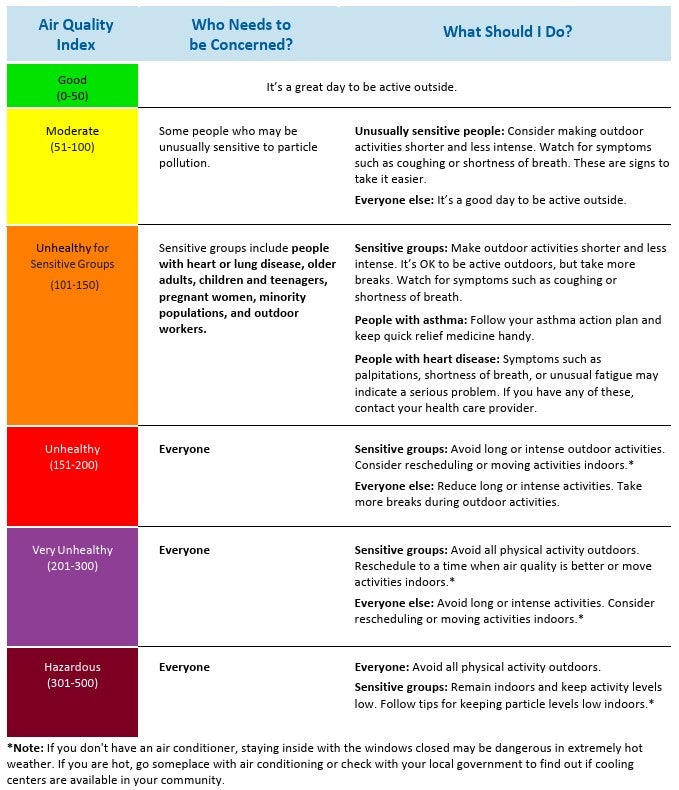Smoke and Air Quality
This information is provided by the Nebraska Department of Water, Energy, and Environment to assist the public and regulated community.
Smoke and its Impact on Health
The smoke created by fires can present public health concerns. Smoke contains air pollutants that can be harmful when inhaled, and can be transported long distances, covering large areas of the continent before dissipating. Smoke transport is dependent on numerous factors such as temperature, humidity, and wind conditions.
The pollutant most often associated with smoke impacts is fine particulate matter, or PM2.5. These particles have a diameter of 2.5 microns or less – smaller than that of a human hair – and can be inhaled deeply into the lungs.
National Ambient Air Quality Standards (NAAQS)
The Environmental Protection Agency (EPA) has established health-based (primary) NAAQS for PM2.5 as noted below:
| Daily (24-hour) NAAQS | 35 ug/m3 (based on a 24-hour average) |
| Annual NAAQS | 9 ug/m3 (based on a year-long average) |
Compliance with these standards is evaluated by analyzing air monitoring data over a three-year period. For annual NAAQS, a simple three-year average is used; for the daily 24-hour NAAQS, a more complicated calculation is used (i.e., the three-year average of the 98th percentile values, where the 98th percentile value is the annual 8th highest value when monitoring daily).
Nebraska has eight ambient air monitors that measure PM2.5 concentrations in or near areas of the highest predicted concentrations (Omaha (2), Blair, Bellevue, Lincoln, Beatrice, Grand Island, and Scottsbluff). Data from these monitors indicate that Nebraska complies with the NAAQS, but also that there are instances when daily PM2.5 concentrations exceed the NAAQS. (The daily PM2.5 NAAQS allows for 7 exceedances per year as described above i.e., the 24-hour average uses the 8th highest value.)
Air Quality Index (AQI)
EPA has developed the AQI to provide the public a simple matrix for real-time air quality conditions. Think of the AQI as a yardstick, ranging from 0 to 500 – the higher the AQI, the greater the level of air pollution and health concern. AQI levels and recommended actions are shown in the following table.

Source: https://document.airnow.gov/air-quality-guide-for-particle-pollution.pdf
What Does the AQI Level Mean in terms of the PM2.5 Concentration?
The PM2.5 AQI levels (24-hour) correspond to pollutant concentrations as follows:
| AQI Category | PM2.5 Concentration Level |
| Good | less than 9 ug/m³** |
| Moderate | 9.1-35 ug/m³ ** |
| Unhealthy for Sensitive | 36-55 ug/m³ |
| Unhealthy | 56-125 ug/m³ |
| Very Unhealthy | 126-225 ug/m³ |
| Hazardous | greater than 226 ug/m³ |
Source: https://aqs.epa.gov/aqsweb/documents/codetables/aqi_breakpoints.html
** Values in the ‘Good’ and ‘Moderate’ category correspond to concentrations that are within the 24-hour NAAQS for PM2.5.
Occasionally Nebraska may experience daily exceedances of the NAAQS for PM2.5, but because the 8th highest value is used when determining compliance, past exceedances have not resulted in regulatory violations of the standard. However, when a short-duration exceedance occurs, it can and does have public health impacts as indicated in the AQI table above. The source of the smoke is predominantly from outside Nebraska and the frequency of these episodes has not resulted in violation of the NAAQS, so Nebraska currently has no regulatory recourse to address these exceedances.
How can I evaluate the impact of smoke in the air?
· Check the AQI – current conditions and the forecast are available on EPA’s AirNow website (www.airnow.gov). For data from Nebraska monitors and sensors, please visit https://fire.airnow.gov/ - click on the individual monitor or sensor to open the data window and scroll for data and info. Please note that data from past smoke incidents indicate that the AirNow forecasts lack some accuracy in relating current air quality conditions to the 24-hour average conditions.
· Check local health agency and DWEE webpages and social media for updates.
· Use your senses. Is the air hazy? Does it smell smoky? Elevated concentrations of PM2.5 produce a visible haze that may indicate smoke impact before you smell the odor of smoke.
· Past incidents tend to follow a similar pattern:
· Prescribed burning – smoke tends to accumulate in the late afternoon or evening hours, is most noticeable in the early morning hours, and then dissipates in mid-late morning as temperatures increase.
· Wildfires – smoke may accumulate at any time of the day, and can be persistent and linger, sometimes over a period of days.
· Plan activities accordingly to avoid periods of highest PM2.5 and smoke impacts using the AQI table as a guide.
DWEE is committed to working with other states and sources of smoke to minimize and, if possible, eliminate adverse impacts. Comments, suggestions and questions regarding air quality issues and agency activities are welcomed. For more information, contact DWEE at (402) 471-2186, or toll free at 1-877-253-2603; e-mail – DWEE.moreinfo@nebraska.gov.
Resources
